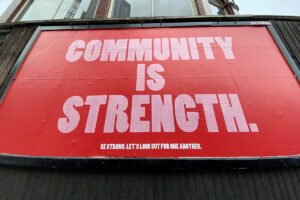
The climate crisis is not “gender neutral.” Worldwide, women and girls are disproportionately affected. Age, poverty, ethnicity, and marginalization exacerbate existing gender inequalities and pose particular threats to women’s livelihoods, health, and safety. But how much attention is paid to gender inequality in global discussions about the impact of and fight against climate change?
I had the opportunity to attend the United Nations climate conference (SB 60) in Bonn, Germany in June 2024 as an observer and youth representative. I was able to witness firsthand the lack of attention paid to the issue of gender inequality and the impacts of climate change on women and girls. It is clear that significant global and country-level actions are required to counteract the growing imbalance.
How Climate Change Contributes to Gender Inequality
Adolescent girls are more likely to be forced into marriage to alleviate the financial difficulties caused by extreme weather events.Climate change disproportionately affects groups most dependent on natural resources for their livelihoods. Globally, women are more dependent on—yet have less access to—natural resources, including water and minerals. Women and girls are most severely affected by natural disasters such as droughts, landslides, and floods. Female-headed households lose 8 percent more income due to heat stress and 3 percent more due to flooding. And in 2021, food insecurity among adult women rose to 31.9 percent from 27.5 percent in 2019.
According to data from the organization UN Women, approximately 20 million more women live in poverty than men, significantly affecting their health and wellbeing. Children, particularly girls, face similar challenges. Because girls are responsible for much of their families’ domestic work, when climate change disrupts rainfall patterns, girls have to spend more time fetching wood and water over longer distances. This in turn, causes them to miss out on education and increases their exposure to violence.
Adolescent girls are more likely to be forced into marriage to alleviate the financial difficulties caused by extreme weather events. Climate-induced displacement also strains social and health services, including access to menstrual hygiene and sexual and reproductive health. The UN’s Progress on the Sustainable Development Goals: The Gender Snapshot 2023 predicts that in a worst-case scenario, climate change could push up to 158.3 million more women and girls into poverty by midcentury, outnumbering men and boys by at least 16 million.
“If you are invisible in everyday life, your needs will not be thought of in a crisis situation, let alone addressed,” according to Matcha Phorn-in, a human rights defender who works to empower stateless and landless Indigenous women, girls, and young LGBTQ+ people in the Thai provinces of Chiang Mai, Mae Hong Son, and Tak.
The Conference’s Failure to Address Concerns
At the conference in Bonn, gender inequality received the most attention in the revisiting of the Lima Work Programme on Gender (LWPG) and the Gender Action Plan (GAP). Established in 2014, the LWPG aims to integrate gender-specific considerations and measures into climate policy. The GAP, created in 2021, focuses on strengthening the rights, resources, and representation of women and marginalized groups. During SB 60, discussions centered previous GAP implementation, resulting in a summary report. However, no new steps were taken; instead, time was spent revisiting previously defined, unproblematic formulations.
Similarly, with the LWPG, considerable time was taken discussing and undoing already established formulations and funding. The conference failed to agree on a new and ambitious program, postponing the consideration and adoption of an expanded plan to COP29, to be held in November 2024. Consequently, both a renewed gender work program and a corresponding action plan are missing.
Angela Baschieri, the technical lead on climate action at United Nations Population Fund (UNFPA), emphasizes the need for action and urgency on gender issues in this field, stating in an interview, “Gender commitments in the UN climate process must be more ambitious and include actionable targets for countries to address gender inequality.”
“We now have so much evidence that climate policy is not as effective if it is not gender equitable.”
Sign up for our free newsletters
Subscribe to NPQ's newsletters to have our top stories delivered directly to your inbox.
By signing up, you agree to our privacy policy and terms of use, and to receive messages from NPQ and our partners.
To achieve this, a stronger blueprint on gender and climate is essential—one that clearly identifies concrete national focal points responsible for supporting negotiations, implementation, and monitoring.
During the last days of SB 60, Rebecca Heuvelmans, a representative of the Women and Gender Constituency, appealed to the conference to “seize the opportunity to stand with those who are bearing the brunt of the climate crisis by working together towards a strong LWP and GAP.”
The critical connection between the climate crisis and the ever-increasing associated dangers for women and children was highlighted in several compelling side events at the conference, such as the “Enhancing Gender Equality in Climate Action” by the Africa Women and Gender Constituency, the “Climate Justice & Gender Equality” event, and the “Marrakech Partnership Workshop on Gender Mainstreaming.”
Several representatives emphasized during these discussions the need to integrate climate finance talks with negotiations on gender equality, rather than treating them as separate issues. A representative from a small island state underscored the significance of incorporating the lived experiences of her community into political decision-making. She urged that the suffering and devastation brought on by climate change be acknowledged and addressed within the political dialogue.
Sascha Gabizon, executive director of Women Engage for a Common Future International, a network of feminist groups focused on environmental issues, reinforced the critical importance of gender inclusion. She stated, “We now have so much evidence that climate policy is not as effective if it is not gender equitable.”
Young Women and Girls Need a Platform
Despite the importance of these discussions, they are often confined to smaller side events. But the urgency and significance of addressing gender equality in the context of climate change mean these issues should play a prominent role throughout the entire event and be at the forefront of the climate agenda. These topics should not only be acknowledged but should also inspire swift and decisive action.
To do so, women need a platform to raise public awareness and for their problems and concerns to be heard and addressed. Women are the most reliable sources for understanding the extent of gender discrimination and identifying what is needed to support them.
In recent years, youth voices have become increasingly prominent in climate discussions. It is essential that a significant number of these youth representatives be female, to represent the perspectives both of young people and of girls and women in the climate crisis.
As another representative passionately emphasized, another chance to provide this platform is coming soon: “COP29 should be a COP for peace, and we cannot have peace without justice.”








